| DESCRIPTION | HISTORY | DATING |
Please Click On Any Picture for a Larger Version
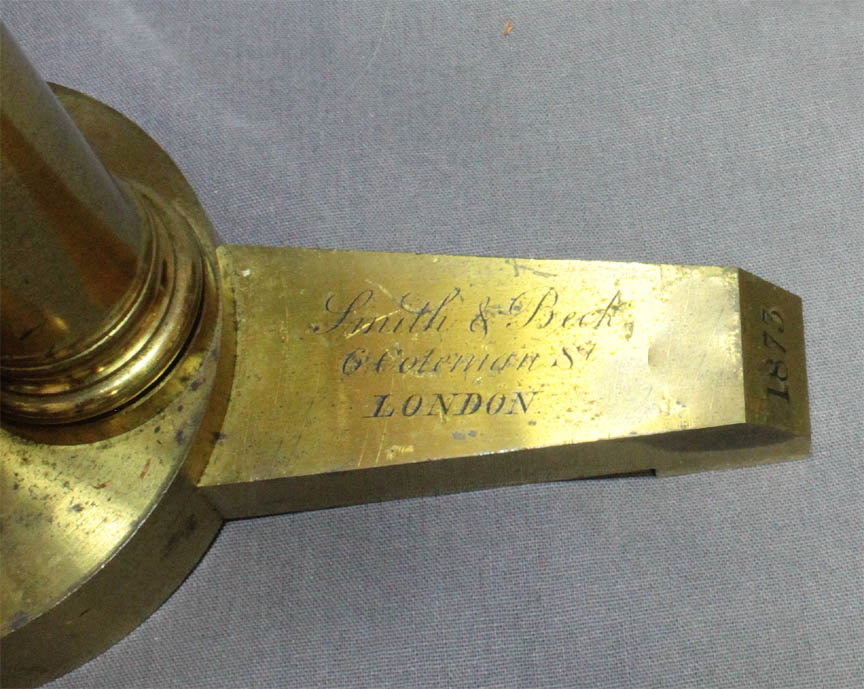
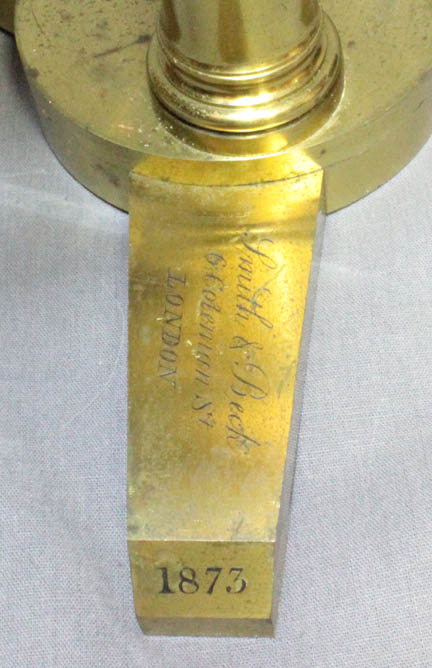 This is a fine example of the binocular double-pillar Smith & Beck Best No 1 compound microscope with a square mechanical stage. It arises from a rotating circular plate on a flat tripod foot. The foot is signed: 'Smith & Beck, 6 Coleman St, London' and engraved with the serial number on the edge '1873'. The Lister-Jackson limb is suspended between the twin pillars via trunions.
This is a fine example of the binocular double-pillar Smith & Beck Best No 1 compound microscope with a square mechanical stage. It arises from a rotating circular plate on a flat tripod foot. The foot is signed: 'Smith & Beck, 6 Coleman St, London' and engraved with the serial number on the edge '1873'. The Lister-Jackson limb is suspended between the twin pillars via trunions. 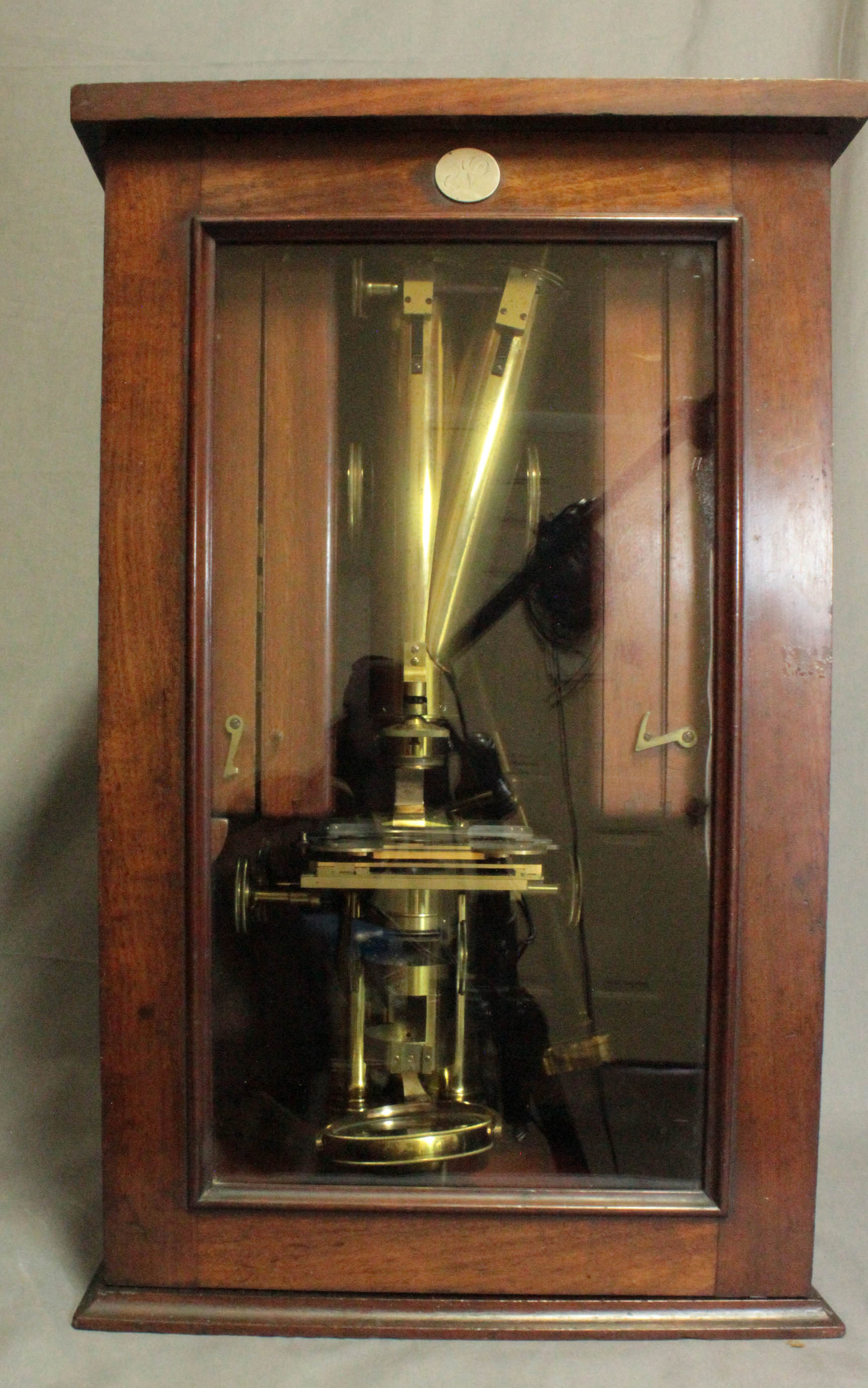
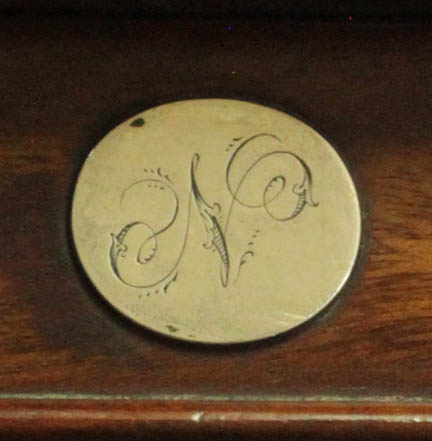 The main case is an original Smith & Beck case but was likely an upgrade when the microscope itself was upgraded from monocular to binocular, sometime in the early 1860's. It has furniture to accomodate the large bench condenser and the two main accessory boxes. The microscope itself slides in and out of the case on a fitted wooden base. The front of the case is glazed and on the upper door is a fancy engraved silver-color metal plate. It is engraved with a capital letter N.
The main case is an original Smith & Beck case but was likely an upgrade when the microscope itself was upgraded from monocular to binocular, sometime in the early 1860's. It has furniture to accomodate the large bench condenser and the two main accessory boxes. The microscope itself slides in and out of the case on a fitted wooden base. The front of the case is glazed and on the upper door is a fancy engraved silver-color metal plate. It is engraved with a capital letter N.
 There are five eyepieces with this set. These include two low power, two medium power and one higher power eyepiece. There are cutouts in the accessory case which do accomodate three of the five; the remaining (lowest power) pair must be stored on the binocular tubes themselves. One of the lowest power eyepieces has an integrated moveable pointer, controlled by a knurled knob.
There are five eyepieces with this set. These include two low power, two medium power and one higher power eyepiece. There are cutouts in the accessory case which do accomodate three of the five; the remaining (lowest power) pair must be stored on the binocular tubes themselves. One of the lowest power eyepieces has an integrated moveable pointer, controlled by a knurled knob. 

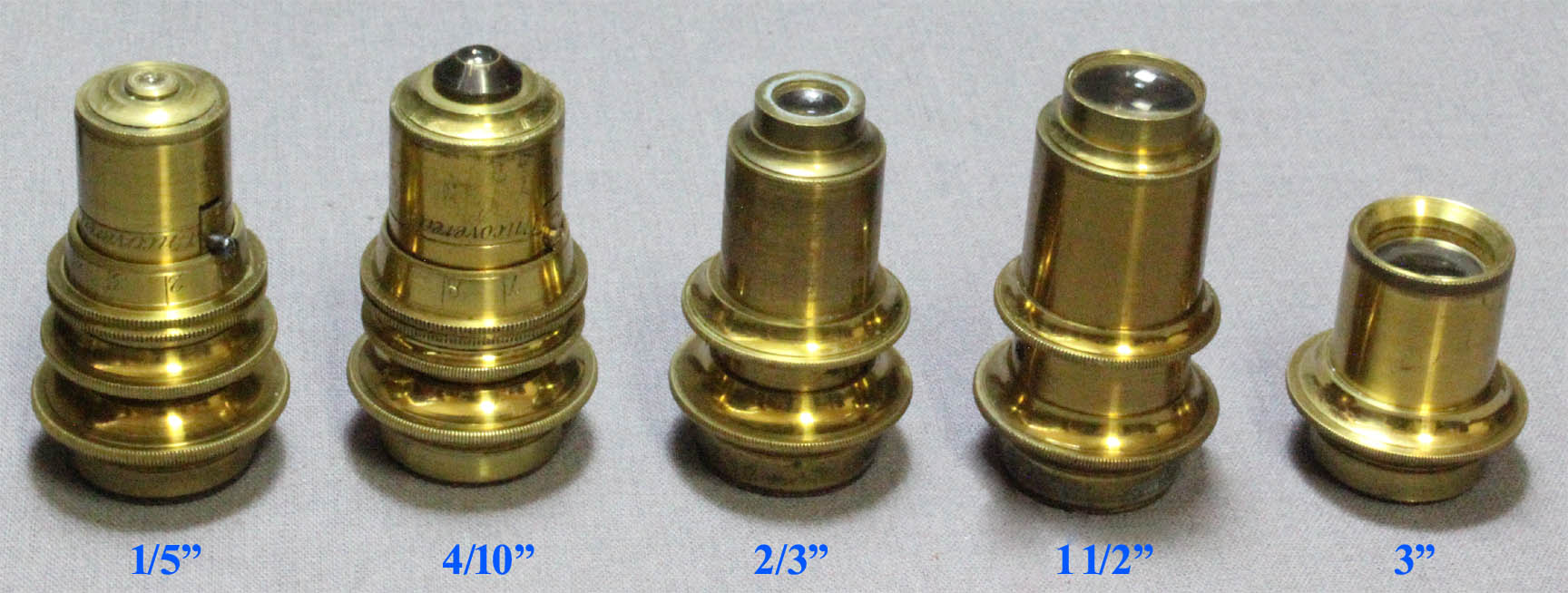 There are five objectives with this set, all in their original cans. They include a 3 inch by Smith, Beck & Beck, a 1 ½ inch by Smith & Beck, a ⅔ inch by Smith & Beck, a 4/10 by Smith, Beck & Beck, and a 1/5 by Smith & Beck. The 4/10 and the 1/5 both have correction collars. There is a Leiberkuhn which fits the ⅔ and one that fits the 4/10.
There are five objectives with this set, all in their original cans. They include a 3 inch by Smith, Beck & Beck, a 1 ½ inch by Smith & Beck, a ⅔ inch by Smith & Beck, a 4/10 by Smith, Beck & Beck, and a 1/5 by Smith & Beck. The 4/10 and the 1/5 both have correction collars. There is a Leiberkuhn which fits the ⅔ and one that fits the 4/10.
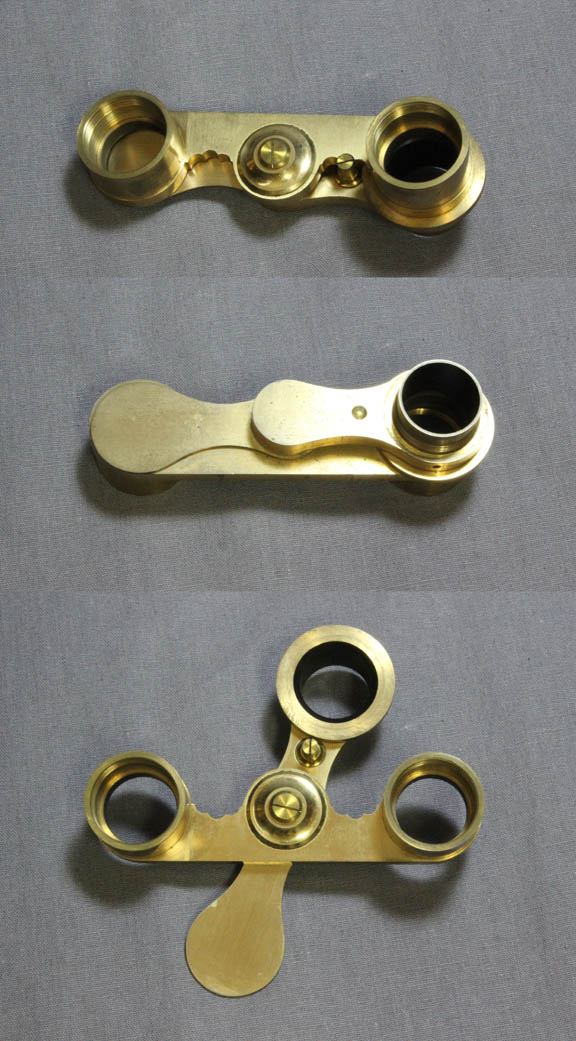
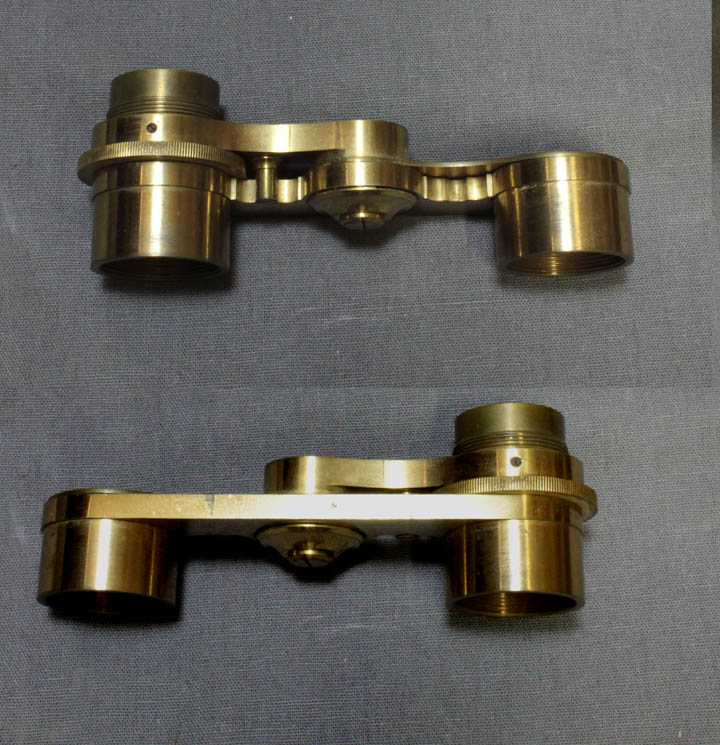 The firm supplied a double objective changer for this relatively early model. It has a knurled attachment knob to secure it in any desired position. In later years a quadruple objective changer was routinely supplied with the Best stands.
The firm supplied a double objective changer for this relatively early model. It has a knurled attachment knob to secure it in any desired position. In later years a quadruple objective changer was routinely supplied with the Best stands. 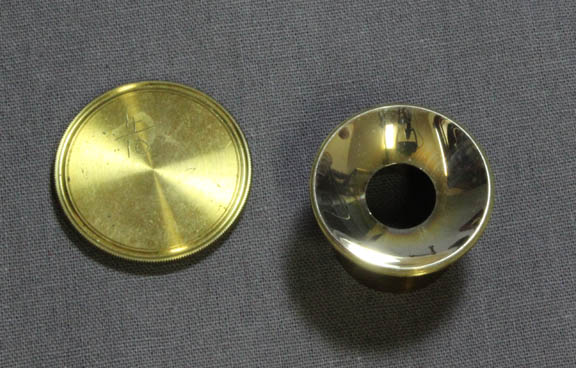
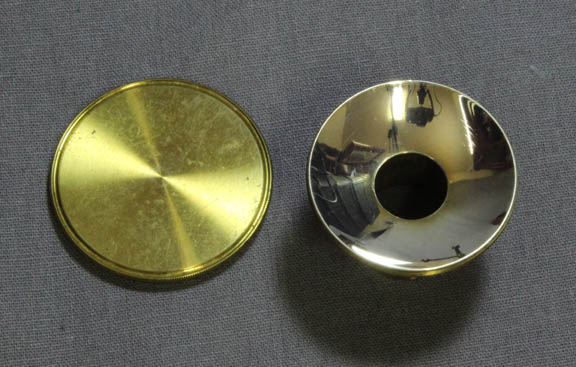 Two lieberkun reflectors for viewing opaque objects are included, one for the 4/10 inch objective(left), and one for the 2/3 inch(right). Each of them has a protective cap, each having the size of objective they fit, scratched on the cap.
Two lieberkun reflectors for viewing opaque objects are included, one for the 4/10 inch objective(left), and one for the 2/3 inch(right). Each of them has a protective cap, each having the size of objective they fit, scratched on the cap.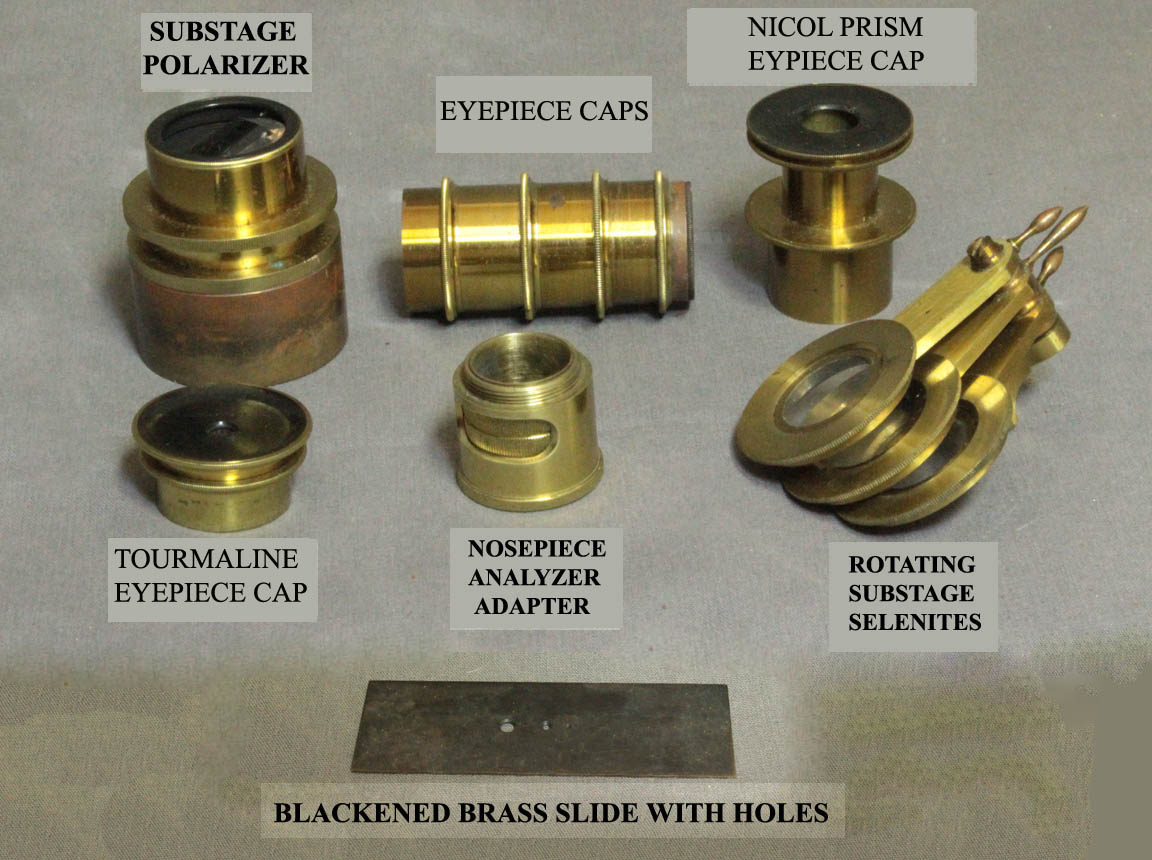 -A large substage Nicol calcite prism polarizer
-A large substage Nicol calcite prism polarizer A substage paraboloid condenser for dark ground illumination is included with the accessories. It has two slightly raised contact bands on the barrel. This accessory is damaged, having internal cracks in the glass, and some verdigris corrosion near the lens. Its stop is frozen in the downward-most position.
A substage paraboloid condenser for dark ground illumination is included with the accessories. It has two slightly raised contact bands on the barrel. This accessory is damaged, having internal cracks in the glass, and some verdigris corrosion near the lens. Its stop is frozen in the downward-most position.
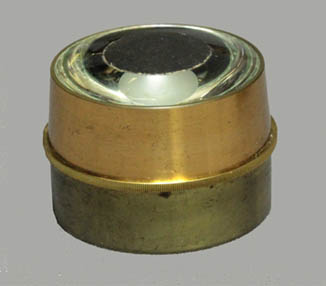 Another substage accessory for dark ground illumination is a large parabolic 'spot lens' condenser. Unlike the paraboloid, this device is in perfect operating condition. It has a large black circle on top to block central light rays, and a frosted spot of smaller size on the bottom surface. In this way only oblique rays from the angled clear glass can reach the specimen, allowing dark ground illumination. This device is used for dark ground work with lower power objectives.
Another substage accessory for dark ground illumination is a large parabolic 'spot lens' condenser. Unlike the paraboloid, this device is in perfect operating condition. It has a large black circle on top to block central light rays, and a frosted spot of smaller size on the bottom surface. In this way only oblique rays from the angled clear glass can reach the specimen, allowing dark ground illumination. This device is used for dark ground work with lower power objectives. 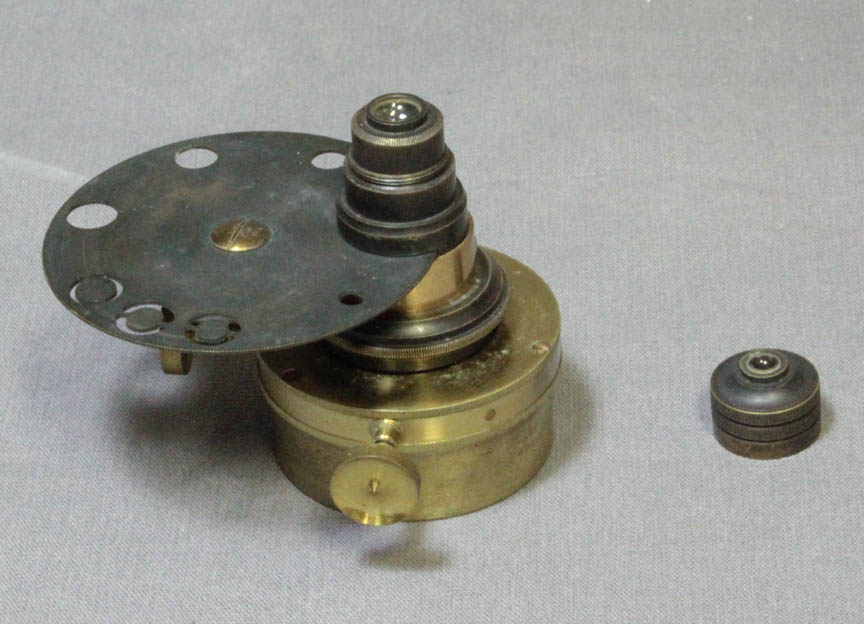 An achromatic condenser is in a mount which allows adjustment of centration by two small knurled knobs 90o from each other. It has a single wheel which incorporates 3 stops and 5 apertures. The upper optical elements can be removed for use with lower power objectives.
An achromatic condenser is in a mount which allows adjustment of centration by two small knurled knobs 90o from each other. It has a single wheel which incorporates 3 stops and 5 apertures. The upper optical elements can be removed for use with lower power objectives.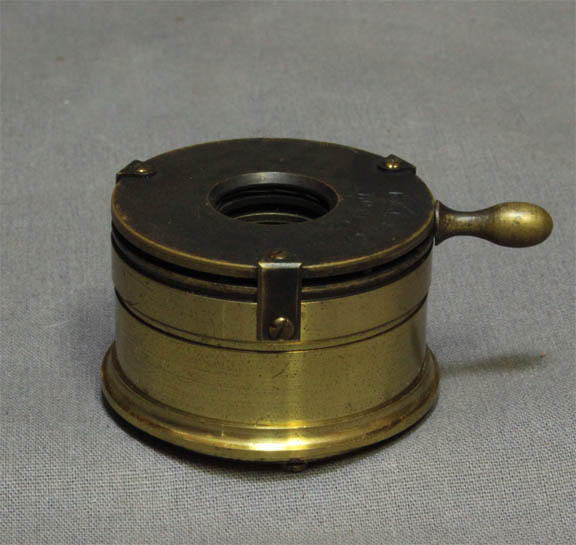
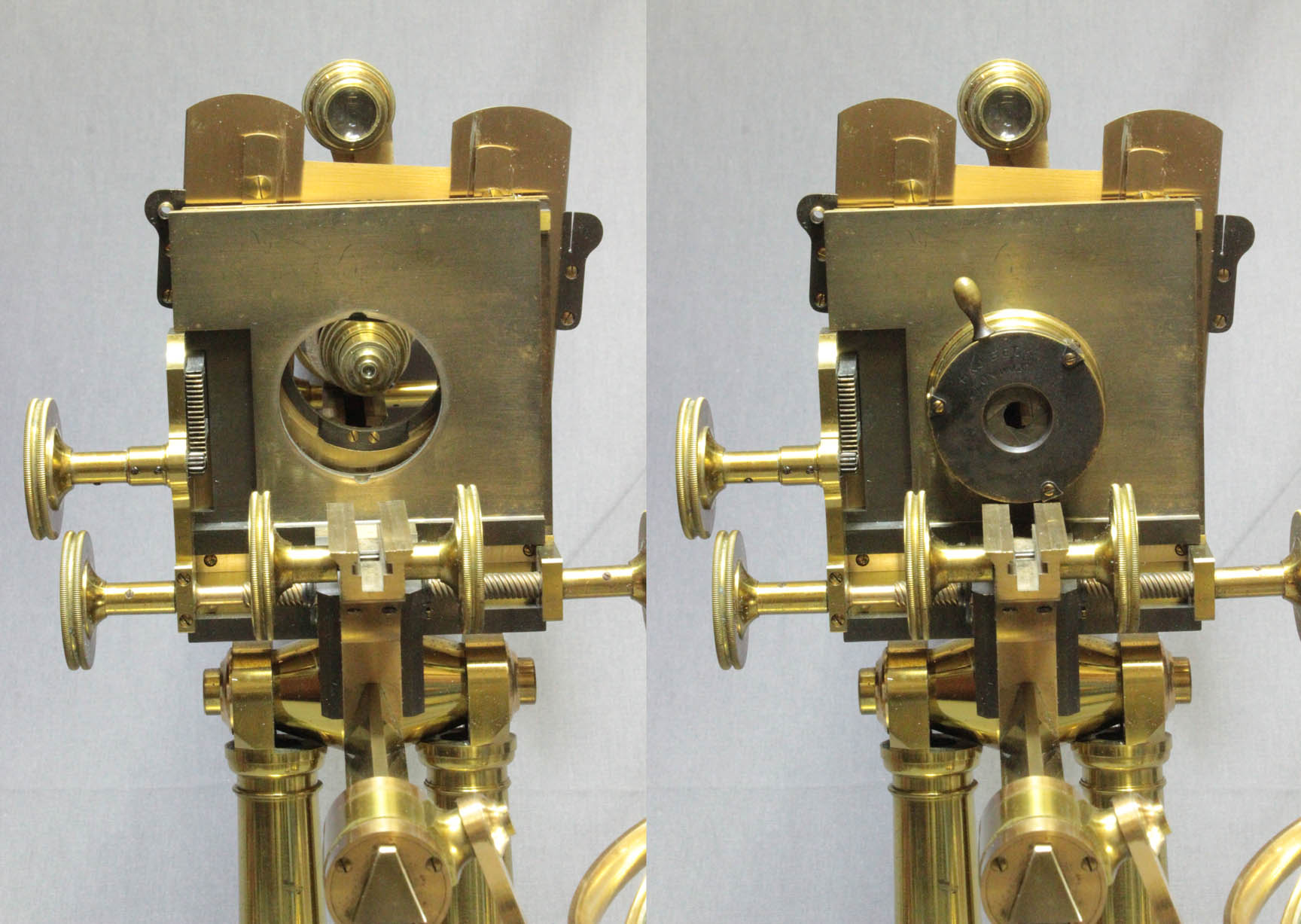 An accessory that may be used without the other condensers is an iris diaphragm in a barrel that attaches by bayonet fittings under the stage. This piece is signed 'R. & J. Beck'. It must be removed to use the substage condensers or the darkwell fitting. It is most useful when using the mirror or prism illuminators without condensers.
An accessory that may be used without the other condensers is an iris diaphragm in a barrel that attaches by bayonet fittings under the stage. This piece is signed 'R. & J. Beck'. It must be removed to use the substage condensers or the darkwell fitting. It is most useful when using the mirror or prism illuminators without condensers. 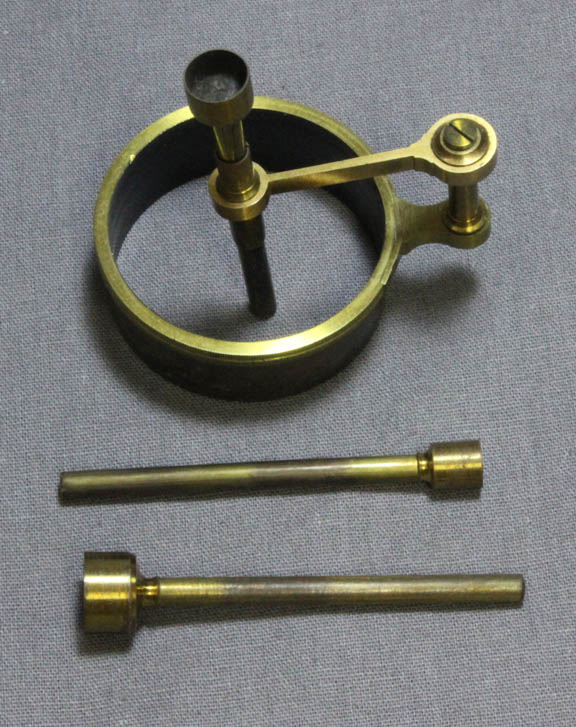 A substage darkwell-holder is included complete with 3 darkwells. This provided a small darkened chamber to view 3 dimensional objects with top lighting against a dark background to avoid reflective glare and extraneous light.
A substage darkwell-holder is included complete with 3 darkwells. This provided a small darkened chamber to view 3 dimensional objects with top lighting against a dark background to avoid reflective glare and extraneous light.
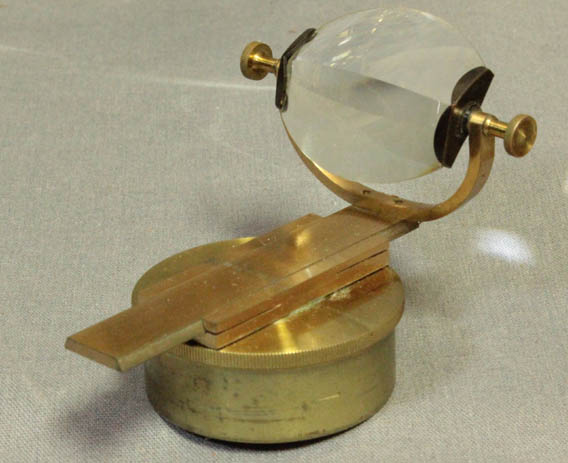 An adjustable Amici-type prism illuminator fits into the top of the moveable substage. It is adjustable to provide oblique lighting as desired.
An adjustable Amici-type prism illuminator fits into the top of the moveable substage. It is adjustable to provide oblique lighting as desired.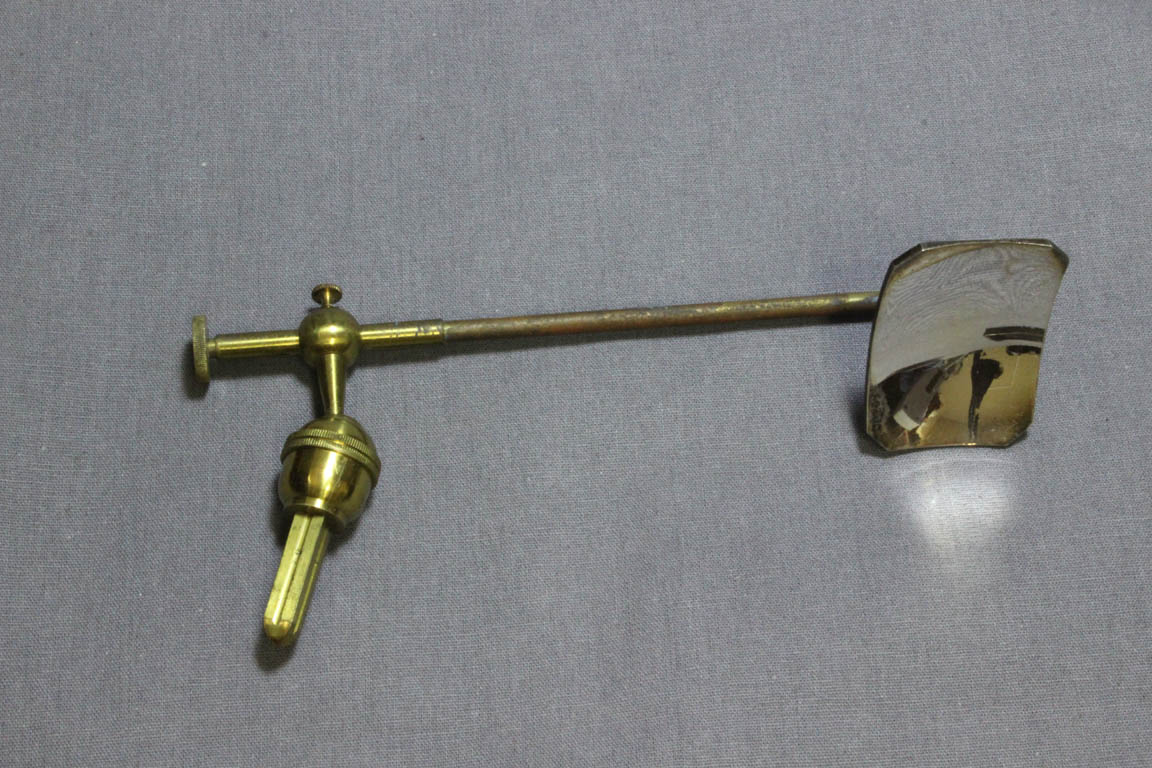 A curved silvered side illuminator is designed to fit into one of the square holes in the limb. It has several versatile sdjustments. It has a blackened brass protective cap which fits over the reflecting surface when not in use.
A curved silvered side illuminator is designed to fit into one of the square holes in the limb. It has several versatile sdjustments. It has a blackened brass protective cap which fits over the reflecting surface when not in use.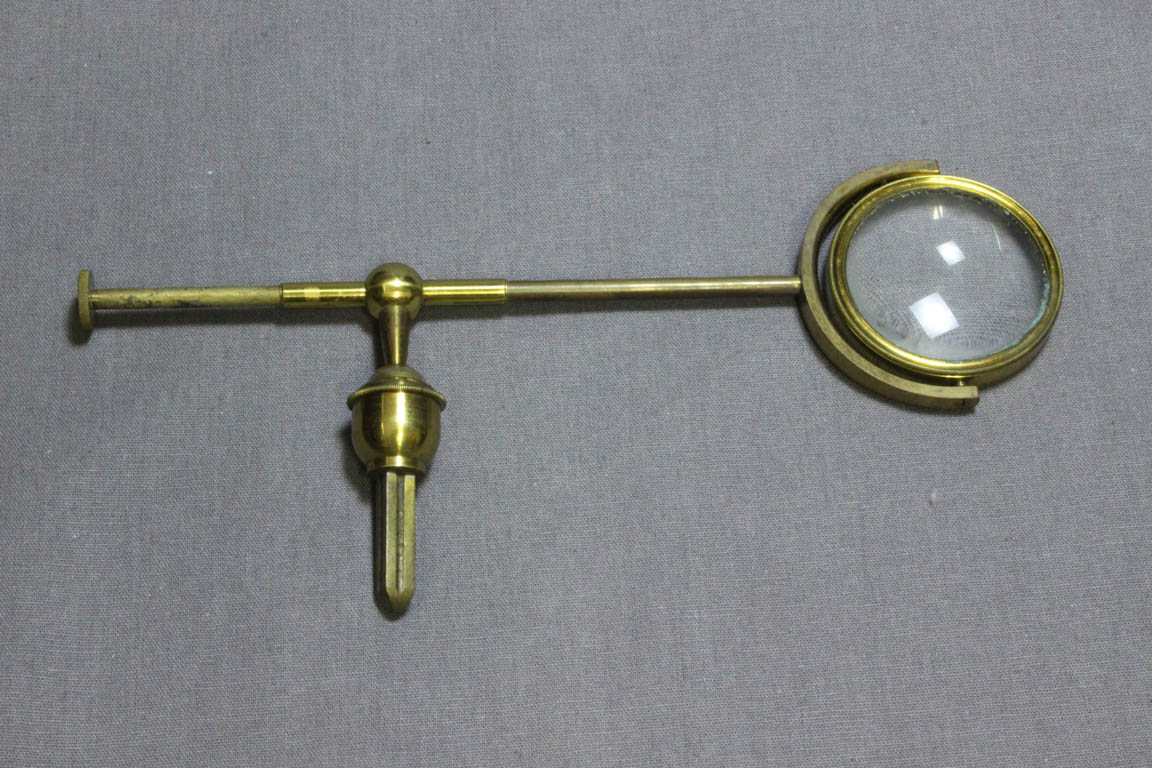 A bullseye condenser for top illumination sits in a gimbal and attaches to the limb like the side illuminator. It too has adjustments for a variety of positions.
A bullseye condenser for top illumination sits in a gimbal and attaches to the limb like the side illuminator. It too has adjustments for a variety of positions.
 A stage-mount forceps has a cork at one end for pinning objects to it. This type of stage forceps has one fixed thick metal leaf, and a single flexible spring leaf to hold objects like a leaf or insect wing etc. This was a common accessory, though most examples have both leaves made of spring metal.
A stage-mount forceps has a cork at one end for pinning objects to it. This type of stage forceps has one fixed thick metal leaf, and a single flexible spring leaf to hold objects like a leaf or insect wing etc. This was a common accessory, though most examples have both leaves made of spring metal.
 A livebox can be used on the stage and still has its original glass.
A livebox can be used on the stage and still has its original glass.
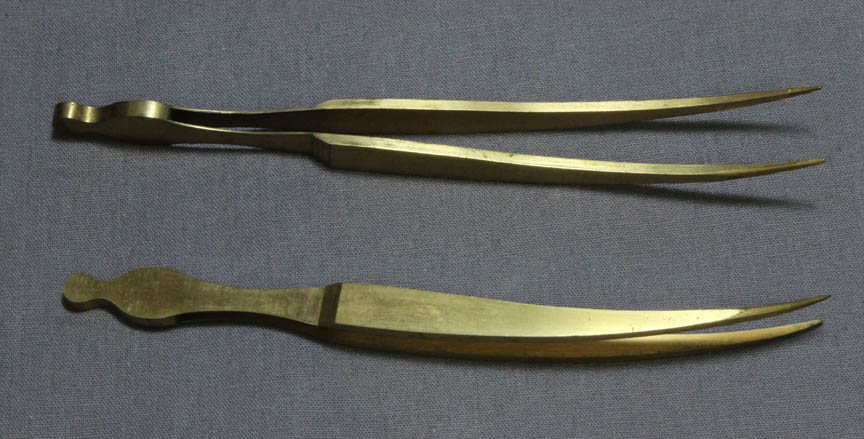 A lacquered brass hand forceps is included in the set.
A lacquered brass hand forceps is included in the set.
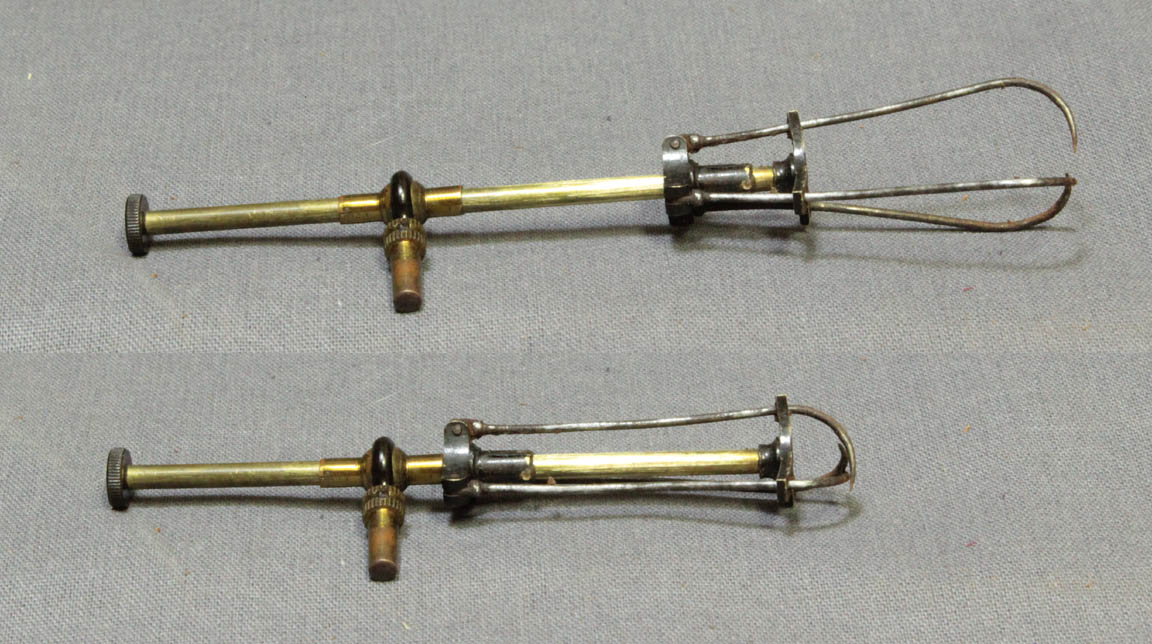 A 3 sided forceps with sharp points attaches to the stage and adjusts to hold irregularly shaped objects, either within its wires, or by the sharp pointed tips. It can hold something delicate, porous or firm, even with an irregular shape, within the range of its adjustable jaws. The jaws are adjusted by sliding the triangular support piece attached to the bases of the prongs closer to or further away from the fixed support piece. The prongs are made of steel. This accessory is not as common as the ordinary stage forceps or liveboxes are.
A 3 sided forceps with sharp points attaches to the stage and adjusts to hold irregularly shaped objects, either within its wires, or by the sharp pointed tips. It can hold something delicate, porous or firm, even with an irregular shape, within the range of its adjustable jaws. The jaws are adjusted by sliding the triangular support piece attached to the bases of the prongs closer to or further away from the fixed support piece. The prongs are made of steel. This accessory is not as common as the ordinary stage forceps or liveboxes are.
 Glass accessories include the larger version of the Beck trough, complete with spring, wedge, rectangular glass plate for the bottom, and the tilting upright glass piece. This is essentially the same trough included with James Smith's early microscopes, except for the design of the wedge. The wedge and spring acting against the internal glass piece allows the chamber size to vary. In later catalogs, the more delicate wedge found with this set, was offered with a smaller trough, while the thicker wedge found with the earlier Smith microscope on this site was offered with the larger version of trough. These troughs were offered for at least forty years.
Glass accessories include the larger version of the Beck trough, complete with spring, wedge, rectangular glass plate for the bottom, and the tilting upright glass piece. This is essentially the same trough included with James Smith's early microscopes, except for the design of the wedge. The wedge and spring acting against the internal glass piece allows the chamber size to vary. In later catalogs, the more delicate wedge found with this set, was offered with a smaller trough, while the thicker wedge found with the earlier Smith microscope on this site was offered with the larger version of trough. These troughs were offered for at least forty years.
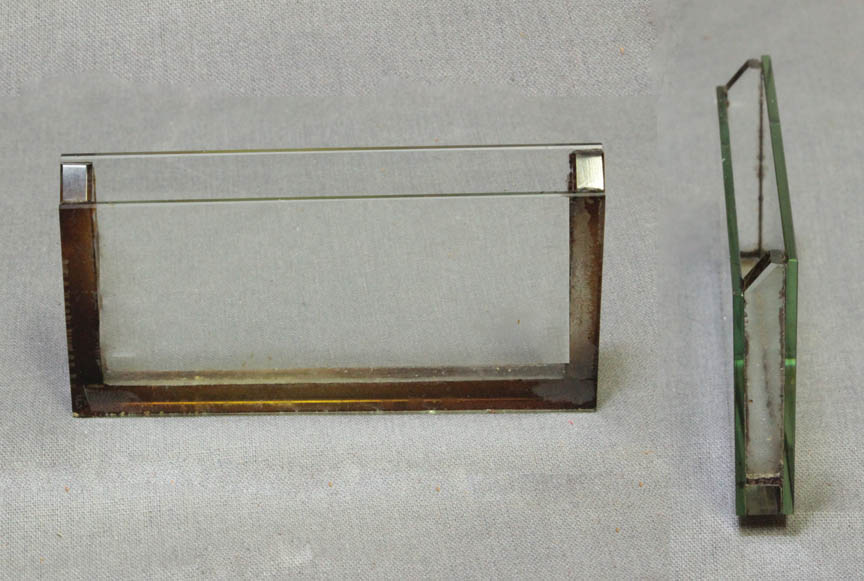 Another thinner, but wider similar trough is also included. This example did not come with other fittings like the wider one.
Another thinner, but wider similar trough is also included. This example did not come with other fittings like the wider one.
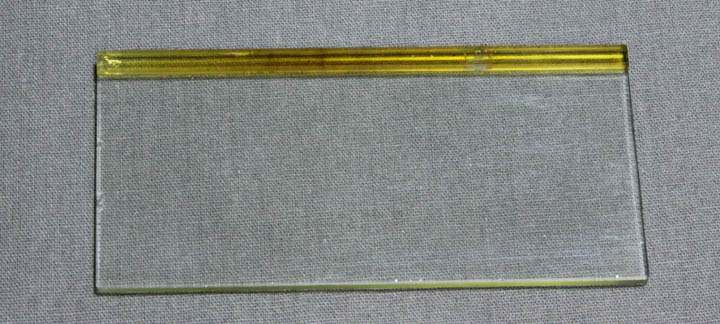
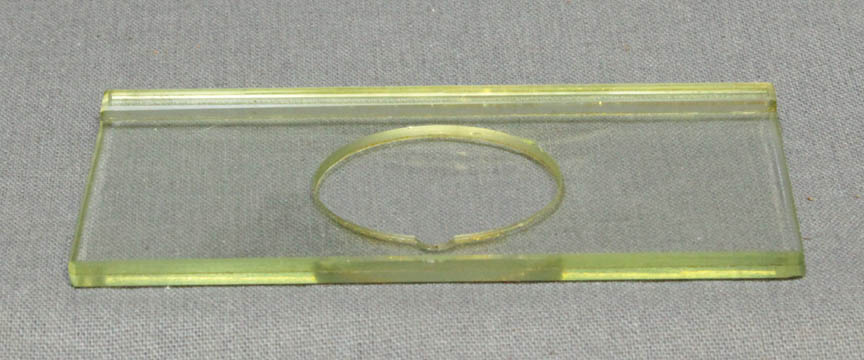 Also made of glass are a ledge slide(left), and a built-up ledge slide for specimens in liquid(right). This latter slide has a thin bottom slide, with another slide with a hole in its center cemented on top of that, forming a chamber. There is also a ledge on this slide. The hole has a small cutout to allow the user to add more liquid under the coverslip as the specimen dries out. A large round coverslip suitable for use with this slide is provided in the red cardboard spares case.
Also made of glass are a ledge slide(left), and a built-up ledge slide for specimens in liquid(right). This latter slide has a thin bottom slide, with another slide with a hole in its center cemented on top of that, forming a chamber. There is also a ledge on this slide. The hole has a small cutout to allow the user to add more liquid under the coverslip as the specimen dries out. A large round coverslip suitable for use with this slide is provided in the red cardboard spares case.
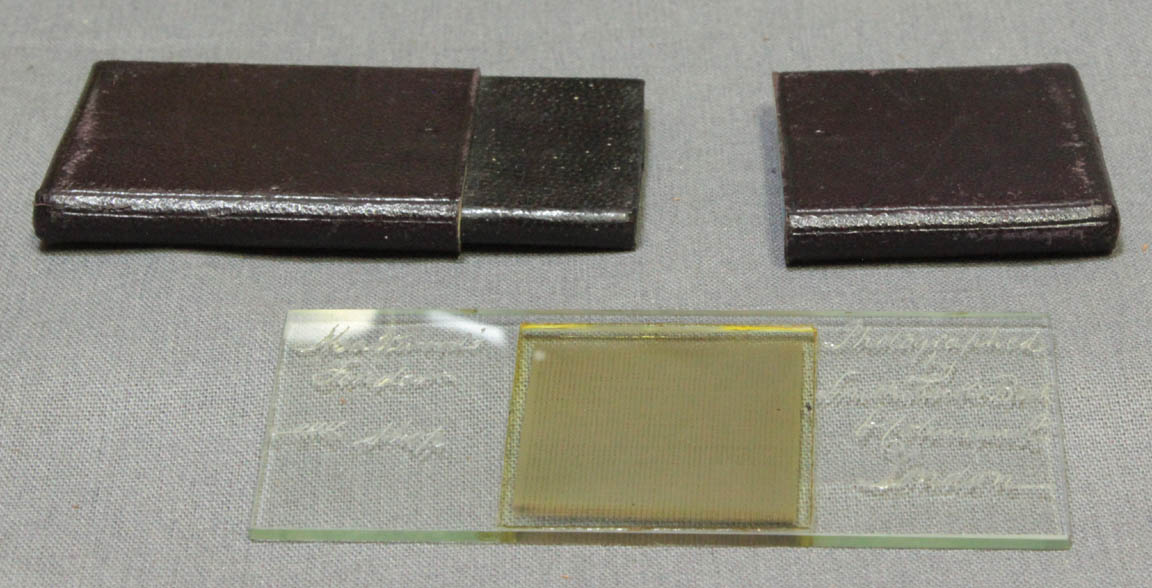 A Maltwood finder in a leather case is included. This device allows one to record a particular standarized location on any slide by recording that position indicated on the finder, so that it can be moved to that location again at a later date by again setting the stage to that location on the finder. It is diamond-engraved on the left side: Maltwood Finder and on that side has an arrow showing where it registers on the stage, labeled 'Stop'. On the right side it is engraved: 'Photographed by Smith, Beck, & Beck, 6 Coleman St, London'
A Maltwood finder in a leather case is included. This device allows one to record a particular standarized location on any slide by recording that position indicated on the finder, so that it can be moved to that location again at a later date by again setting the stage to that location on the finder. It is diamond-engraved on the left side: Maltwood Finder and on that side has an arrow showing where it registers on the stage, labeled 'Stop'. On the right side it is engraved: 'Photographed by Smith, Beck, & Beck, 6 Coleman St, London'
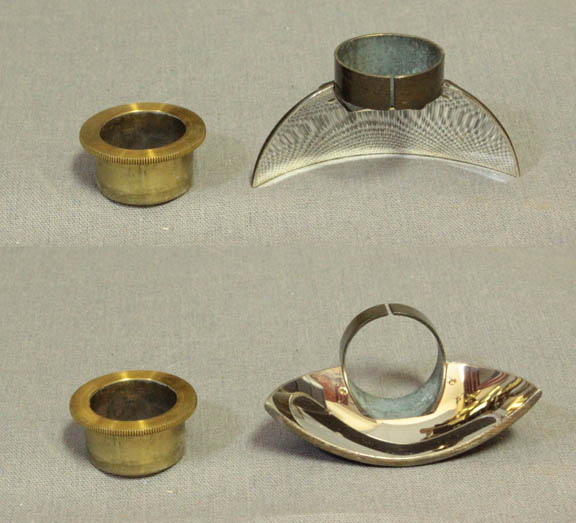 A silvered parabolic reflector which fits on the front of the objectives, is in excellent condition and is housed in an oval lacquered brass case. It has an extra adapter ring which allows it to press fit onto two different diameter objective fronts.
A silvered parabolic reflector which fits on the front of the objectives, is in excellent condition and is housed in an oval lacquered brass case. It has an extra adapter ring which allows it to press fit onto two different diameter objective fronts.
 A separate draw tube is included for high power monocular work. It is calibrated from 1 to 6 inches in 1/10th inch increments, labeled every whole inch.
A separate draw tube is included for high power monocular work. It is calibrated from 1 to 6 inches in 1/10th inch increments, labeled every whole inch.
 A Lister-type erector lens which screws into the bottom of the drawtube is included. It has some damage to the lacquer and slight verdigris around the edge of one of the lens fittings. Optically it is in fine condition.
A Lister-type erector lens which screws into the bottom of the drawtube is included. It has some damage to the lacquer and slight verdigris around the edge of one of the lens fittings. Optically it is in fine condition.
 A Beck-type vertical illuminator in excellent condition is housed in its original brass case. A small blackened brass plate on it is inscribed: 'SMITH, BECK AND BECK, PATENT, LONDON'. It still contains its original coverslip reflector. There is also a spare coverslip for this in the cardboard spares case.
A Beck-type vertical illuminator in excellent condition is housed in its original brass case. A small blackened brass plate on it is inscribed: 'SMITH, BECK AND BECK, PATENT, LONDON'. It still contains its original coverslip reflector. There is also a spare coverslip for this in the cardboard spares case.
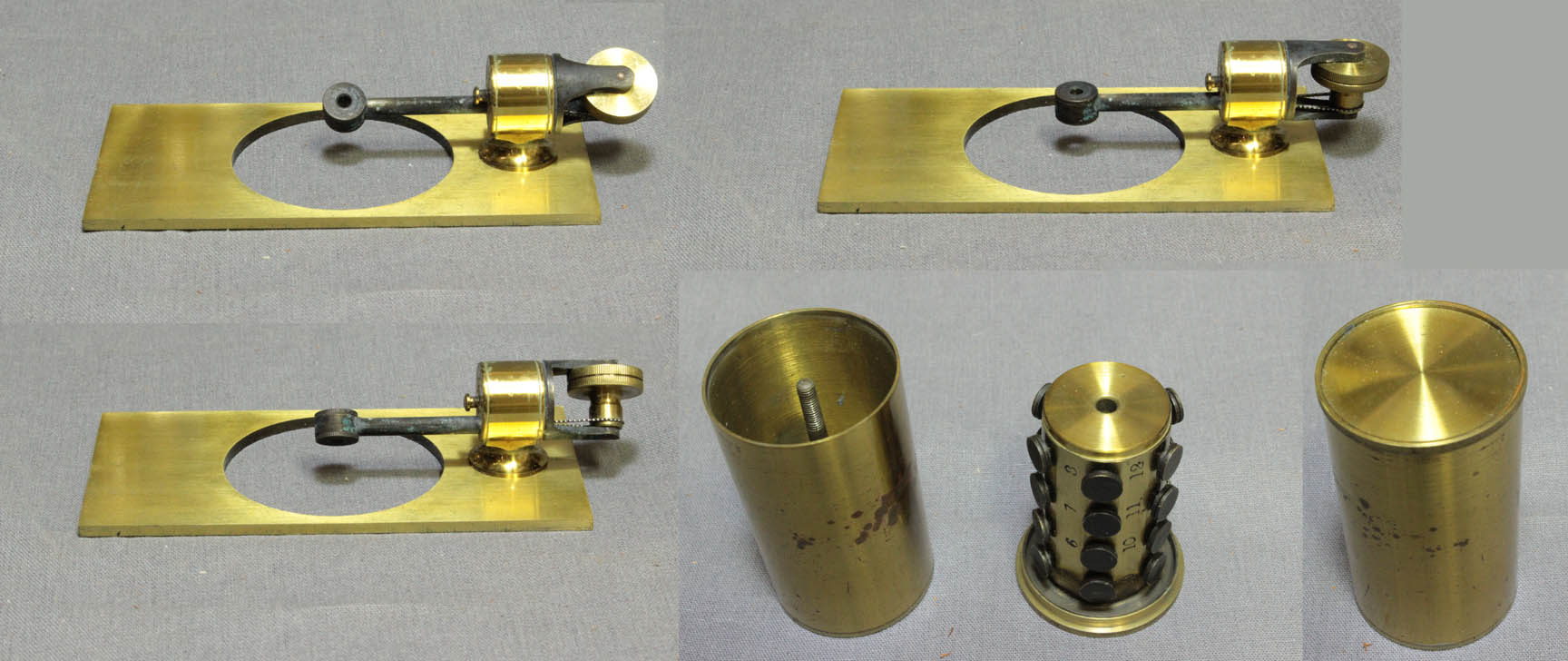
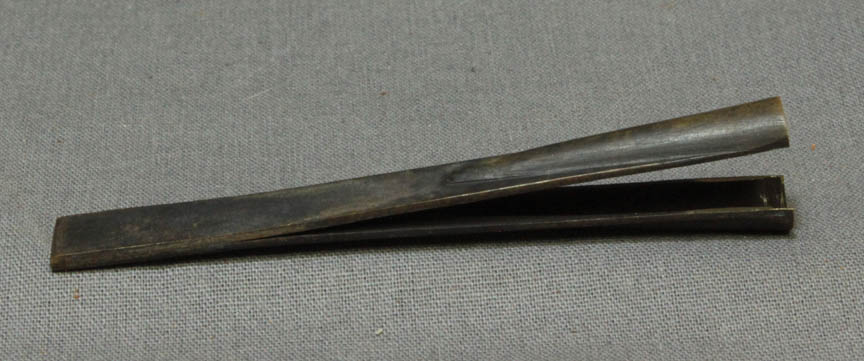 Also in one of the large accessory cases, is a Beck Opaque Disk Rotator apparatus. It is in fine condition, and includes the special tongs as well as a can containing the 24 original disks. The cylinder carrying the disks has a hole that registers on a pin in the can, thus preventing any of the disks from touching the edges of the can. This method of disk storage was one of two types offered by the firm. The other was a series of stacking brass plates as seen on the other example on this site.
Also in one of the large accessory cases, is a Beck Opaque Disk Rotator apparatus. It is in fine condition, and includes the special tongs as well as a can containing the 24 original disks. The cylinder carrying the disks has a hole that registers on a pin in the can, thus preventing any of the disks from touching the edges of the can. This method of disk storage was one of two types offered by the firm. The other was a series of stacking brass plates as seen on the other example on this site.
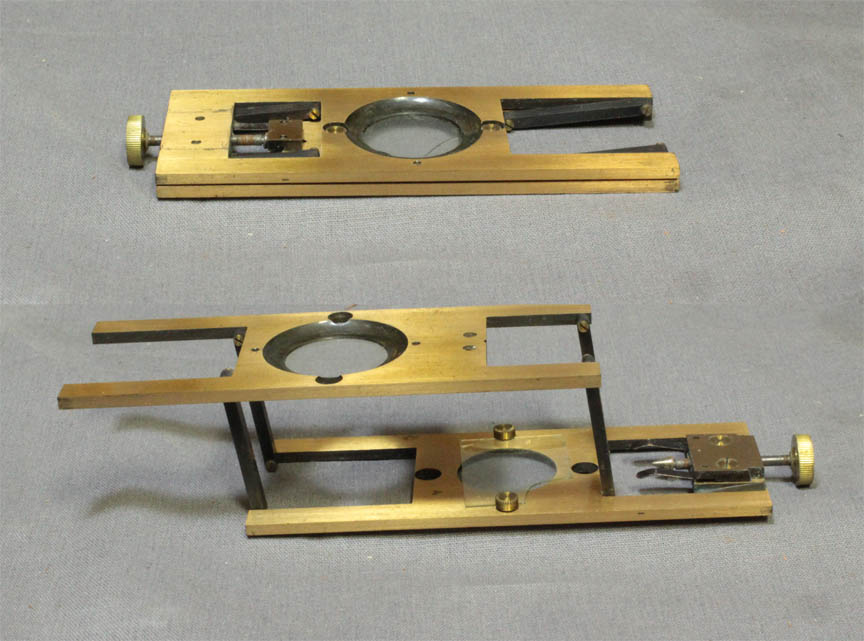 A Beck parallel plate compressor, of the type first introduced about 1855, is included complete with large glass coverslips. In this example, the large rectangular coverslips are attached directly to the plates of the compressor by two tiny knobs. In other examples, removeable blackened metal pieces hold round coverslips. Extras of the large rectangular coverslips are included in the red cardboard spares box. For a review of the various types of compressors, please see the dedicated article on compressors on this site.
A Beck parallel plate compressor, of the type first introduced about 1855, is included complete with large glass coverslips. In this example, the large rectangular coverslips are attached directly to the plates of the compressor by two tiny knobs. In other examples, removeable blackened metal pieces hold round coverslips. Extras of the large rectangular coverslips are included in the red cardboard spares box. For a review of the various types of compressors, please see the dedicated article on compressors on this site.
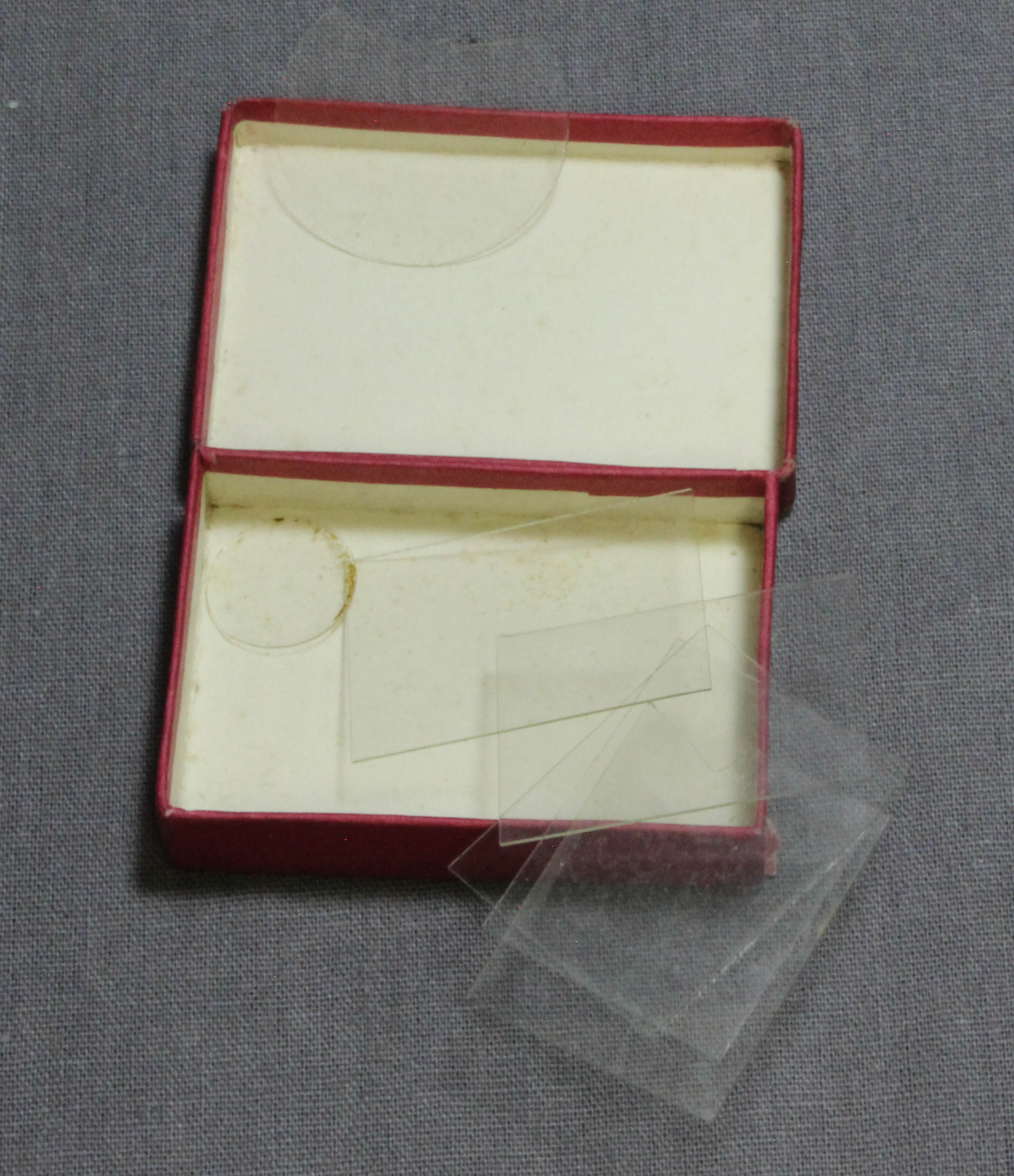 A small red and white cardboard box contains large rectangular spare coverslips for the parallel plate compressor, large round ones for the wet cell, and a smaller round one for the vertical illuminator. At the time this outfit was made, thin class of suitable optical quality was very expensive, so the spares were both a convenience and a cost savings compared to buying new ones individually.
A small red and white cardboard box contains large rectangular spare coverslips for the parallel plate compressor, large round ones for the wet cell, and a smaller round one for the vertical illuminator. At the time this outfit was made, thin class of suitable optical quality was very expensive, so the spares were both a convenience and a cost savings compared to buying new ones individually.

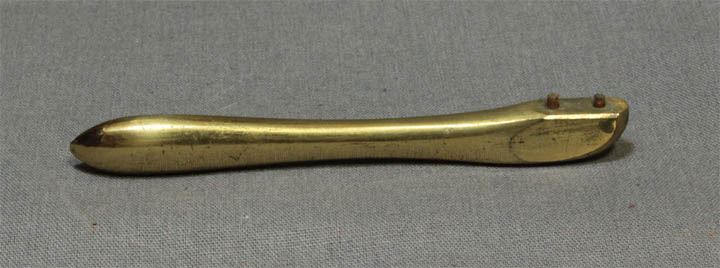 The main accessory cases also contain a diamond-tippled writing implement(left), and a lacquered brass 'key'(spanner wrench, right), to adjust the tension of the inclination joint.
The main accessory cases also contain a diamond-tippled writing implement(left), and a lacquered brass 'key'(spanner wrench, right), to adjust the tension of the inclination joint.
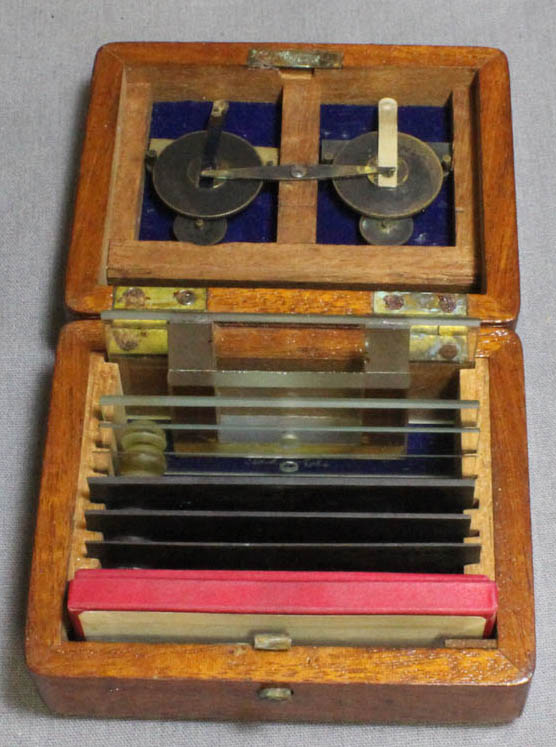 A small wooden case housed in one of the large main accessory cases contains a set of 'Live Traps'
which is described and pictured in more detail on its own dedicated Live Trap Kit page.
A small wooden case housed in one of the large main accessory cases contains a set of 'Live Traps'
which is described and pictured in more detail on its own dedicated Live Trap Kit page.